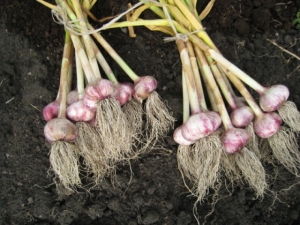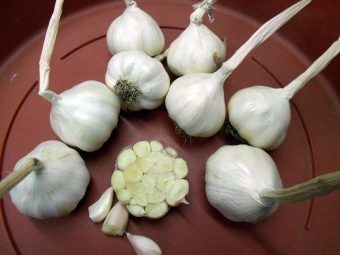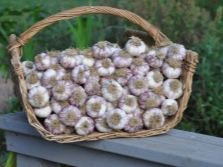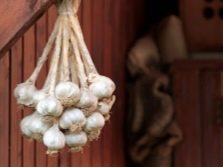When and how to clean garlic?

Garlic is one of the most important crops for gardeners. It is used in home canning and as a seasoning in many kinds of dishes.It also has invaluable healing value. The culture is able to be stored for a long time, but for this it must be properly dug out and create optimal conditions in the future.
Terms for different regions
If you dig up garlic before the deadline, then it will not be stored for a long time, as it must ripen. The first sign is the formed head and yellowed lower leaves. If you overtake the culture in the ground, it will begin to rot, so the time of digging is so important to know and follow it.
If the plant has arrows, then the beginning of the harvesting is indicated by a cracked seed case. Such garlic leaves may not turn yellow, remaining green for a long time, but the quality of the heads will significantly deteriorate. As soon as purple streaks appeared on the arrows, the plant is ready to be harvested. But this rule does not apply to some varieties, such as white garlic.
The timing of the harvest is influenced by climatic conditions. In the Krasnodar Territory, garlic is harvested earlier than in Siberia or central Russia. In Moscow this period falls on the middle of July. Egyptian and Chinese garlic are harvested at the end of the summer.
If the cultivation and harvesting is done right, the gardener will receive a high quality crop. On fully matured plants, the husk can be easily removed, and for testing one or two heads can be dug up. Approaching the timing of the collection of complex (given the climate, appearance and weather), you can accurately determine the time of maturity of garlic heads.
It is impossible not to take into account what kind of garlic in the garden - planted before winter in autumn or spring. The winter and May plants have different collection periods not only in the Crimea or any other southern region, but also in the rest of the country. Winter garlic gives an abundant amount of arrows, it is around them that the head is formed. Spring plant species do not give arrows and form the teeth spirally. They are planted in the spring for the next summer harvest.
Any professional gardener will say that every year it is impossible to specify the dates of culture collection exactly to the day, understanding comes with experience. During the year, you can collect high-quality harvest of different periods in three periods.
- In the spring. These varieties reach about one meter in height. They are consumed fresh, added to food.
- In June. Some experts say that this is too early, as the head may still grow. But the majority of summer residents adhere to this particular period. Dug garlic is dried, processed and stored for storage. The culture is used for twists, since it can lie for no more than three months, then the head dries out.
- The last collection comes at the end of the summer.
In hot regions of the country, harvest for all periods occurs before the specified schedule.
Spring
This type of garlic is planted in early spring, as it does not like dry land and hot weather. If in the south it is April, then in the north of the country the dates are delayed by two weeks, in connection with this and the collection is carried out later. The reference point is the yellow shade of the lower foliage, while the center remains green. In the central regions, work begins at the end of August and even in September; everything depends on the air temperature, the amount of precipitation and other factors.
Inflorescences will not help the summer resident in determining the harvest period. All because their formation simply does not occur. After winter, spring garlic is removed after a couple of weeks, when the shirt keeps the cloves, and they themselves are perfectly formed. It is necessary to remove the culture from the soil even before the heads burst and the cloves become bare. In this state, they are not stored for a long time and begin to rot.
Mature culture is always dense and easily gives the skin on top, it is called “shirt” in common people. Early harvesting is also bad for the culture. If the film is too thick on top of the teeth, and the neck is thick, then it is still too early to dig up the crop.
Professionals in the field of planting crops provide useful recommendations:
- if the season was rainy, then remove the garlic better earlier - an excess of moisture adversely affects the shelf life;
- if the leaves have already laid on the ground, then time is lost;
- dry weather only for some time allows you to delay the time of work.
This culture is not afraid of frosts, but in the heat it stops developing and just rot in the ground. Once the leaves have dried out, this is the first sign that the root system is also no longer functional. By the end of August, most of the foliage shows yellowing.
2-3 weeks before harvest, the plants stop watering. It is better to carry out all the collection work on a dry day and use forks, not a shovel.
Winter
The planting time of winter crops falls on the end of September and the beginning of October. In the southern regions it is possible later, in November, because the ground remains warm there for a long time. Some novice gardeners are wondering why this type of culture is much more popular? Everything is simple - it is easier to take care of it, there is more free time left and you can spend time in spring caring for other plants.
In central Russia, landing is done at the end of July or in August; if you do the same before, the arrows will appear. So that they do not pull the juices on them, it is necessary to break off them, besides, they prepare dishes from the arrows and even freeze them for the winter. It is not necessary to delete everything, they will allow some to determine later when the plant has matured.
The soil is not always a good reference point, as the culture may simply lack moisture or be affected. The cessation of photosynthesis and slower growth is the main thing to rely on, although recognizing the process that has begun is not so easy. That is why the arrows are left, which should stretch out, and the boll opens up, indicating maturity. One hundred days is necessary for garlic to ripen, and this must be taken into account.
As in the case of spring crops, you can see the degree of ripeness of spring garlic by the quality of the head, the skin and the thickness of the neck. Harvested garlic is not stored in the open sun.
There are agronomists who advise to navigate on the lunar calendar, and not only take into account external signs. Many scientists today are inclined to believe that the heavenly body actively influences the biorhythms of plants and not only.
Signs of
It is necessary to clean the beds in time if you want to get a quality crop of early or late garlic, which will be stored for a long time. You need to dig in strictly specified time, and focus on the following signs:
- head quality;
- yellowing of the leaves;
- thickness of the central part;
- whether the seed box on the arrow cracked.
Big mistake gardeners - wait until all the leaves turn yellow. At this time, the head is already starting to deteriorate, so you need to choose the time when there are still green leaves. If you take for a landmark sign on the yellow leaves, then you must be sure that the garlic lacks moisture. Otherwise, the sign will be erroneous, because the same happens from a lack of irrigation.
You need to dig one plant and inspect the head. If the "shirt" has ceased to be dense and easily removed - it's time to get to work.
A sign of readiness of summer garlic is not only lodging of the leaves, but also a decrease in the root collar, the formation of a head with clear teeth, dried scales. The symptoms are almost always the same and do not depend on the type and variety of garlic.
How to dig?
You can not pull the heads of garlic for the stem, and only uproot them. The stem breaks off, the head remains in the soil and it is quite difficult to find it later without damaging. Negligence leads to crop damage. All damaged cultures should go for food, they do not lie for a long time and disappear in a few days.
The ideal time to work after rain is a few days to allow the soil to dry. After the plant has been dug out, it must be shaken and laid on the sun, since only this way it will be possible to dry the top film on the heads, which will become the head protection for several months. Dug out plants can be laid directly on the garden, if good weather is foreseen, or stored in a dry room. The room must be well ventilated, no moisture, otherwise the crop will be covered with mold and rot. A good place for drying - under a canopy.
On the bed, the drying time for normal and dry weather is 5 days. If it is wet outside, but the culture is under a canopy, then dry for 10 days. The sun's rays help to get rid of mold spores, they kill ticks and other pests. In the future, such planting material will be more resistant to damage.
Even garlic dug earlier than the prescribed period can ripen when the gardener properly organizes the drying process. Some deliberately dig up an unripe harvest, as they are afraid of getting overripe heads. With a long stay in the ground culture begins to give repeated shoots, the integrity of the head is destroyed, hence the poor keeping quality. In order to obtain a high quality culture during harvesting, it is worth following a few simple rules:
- cleaning day should be dry and sunny;
- the plantation should not receive additional irrigation for three weeks before it is removed;
- do not use a shovel, it is better to use forks that allow you to remove plants from the soil without damage;
- the plants are laid out on a bed or under a canopy in a single layer and regularly turned over for an even drying process.
It is necessary to prepare for work in advance, the gardener is required not only to stop watering, but also to slightly remove the ground from the heads in order to speed up their ripening. Often, gardeners use the method of binding foliage, when right on the garden stalks of garlic are tied in knots. This method allows you to speed up the ripening process and improve the size of each head.
If rotten were found during digging, damaged plants do not put them in a common pile, but lay them off. Some varieties have quite powerful roots, so pulling them out without undermining will fail.
How to dry after collecting?
While the garlic is drying, it takes the remaining nutrients from the foliage and stem. That is why you can cut the tops and roots after they dry. In this state, the harvest is much easier to store, it takes up less space, you can immerse the heads in wooden boxes. Some knit garlic and hang it on the wall, as an option such storage is also possible.
Inflorescences can be cut and set aside for planting next year. Such a culture is large and healthy, rather than seating it through the teeth. Small root vegetables are taken for food, large ones are left as planting material.
Among most crops, garlic is very capricious in creating the necessary conditions for storage. It can be damaged:
- the sun;
- humidity;
- improper temperature
Humidity in the room should be at a level of from 50 to 80%, just enough to keep the crop from drying out, but at the same time not rotting in containers. This plant does not tolerate high temperature, so it is best to keep the boxes with it in the basement, where the thermometer is only 3-5 degrees. The basement or cellar is considered an ideal place for another reason: it is dark. If this is not possible, then you need to put the culture in the packaging and hang them from the ceiling.
A gardener should consider a ventilation system in the room where garlic is stored. Cut the root system must not fully, leaving a couple of millimeters, and from the stem - 10 centimeters. The same rule applies to cases where the culture is stored in bundles. In addition to cold storage, there is also a warm, at a temperature of 18-20 degrees. If winter garlic to clean in a cold room, then it is great there until spring.
Few gardeners know that it is possible to seal the crop with artificial wax, which helps to preserve the necessary amount of useful elements in garlic cloves and does not allow them to dry out while lying. Although this method is considered quite time consuming, the results will exceed all expectations. Paraffin is melted in a water bath, but it is not brought to a boil, so that the high temperature does not affect the structure of the head of garlic. Now each plant is immersed in the composition so that it covers it completely. One second is enough for a protective film to appear on the garlic. Keep a little wax to dry and put in a box.
If there is no cellar, then a refrigerator, a pantry, but in no case a warmed balcony will be an ideal place to store. The adverse temperature leads to the fact that the heads are affected by diseases and simply shrink.
For information on when and how to pick garlic, see the following video.





































